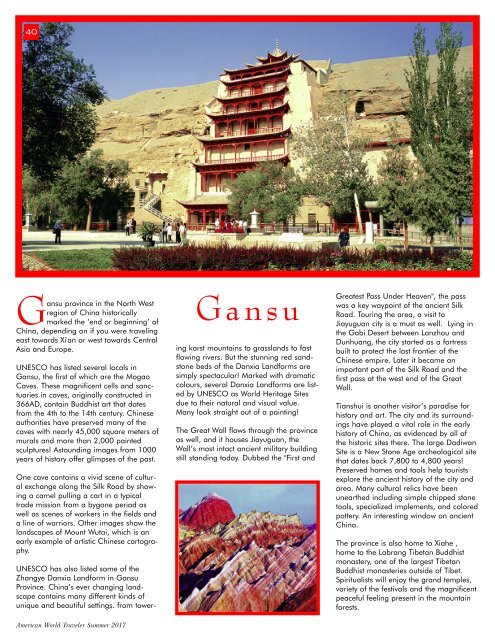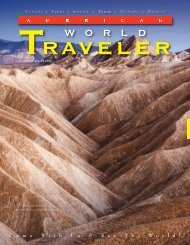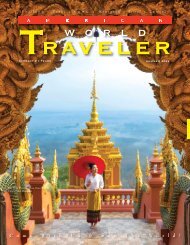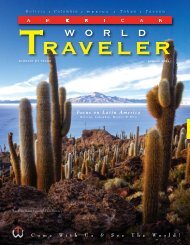American World Traveler Summer 2017 Issue
Now in our 15th year of publishing, American World Traveler explores the culture and history of worldwide destinations, sharing the adventure of discovery with our readers and motivating them to make their travel dreams a reality. Published quarterly, AWT helps sophisticated, independent American travelers choose their next destination by offering a lively blend of intelligent, informative articles and tantalizing photographic images from our World’s best destinations, cruises, accommodations and activities to suit every traveler's taste.
Now in our 15th year of publishing, American World Traveler explores the culture and history of worldwide destinations, sharing the adventure of discovery with our readers and motivating them to make their travel dreams a reality. Published quarterly, AWT helps sophisticated, independent American travelers choose their next destination by offering a lively blend of intelligent, informative articles and tantalizing photographic images from our World’s best destinations, cruises, accommodations and activities to suit every traveler's taste.
Create successful ePaper yourself
Turn your PDF publications into a flip-book with our unique Google optimized e-Paper software.
40<br />
Gansu province in the North West<br />
region of China historically<br />
marked the ‘end or beginning’ of<br />
China, depending on if you were traveling<br />
east towards Xi'an or west towards Central<br />
Asia and Europe.<br />
UNESCO has listed several locals in<br />
Gansu, the first of which are the Mogao<br />
Caves. These magnificent cells and sanctuaries<br />
in caves, originally constructed in<br />
366AD, contain Buddhist art that dates<br />
from the 4th to the 14th century. Chinese<br />
authorities have preserved many of the<br />
caves with nearly 45,000 square meters of<br />
murals and more than 2,000 painted<br />
sculptures! Astounding images from 1000<br />
years of history offer glimpses of the past.<br />
One cave contains a vivid scene of cultural<br />
exchange along the Silk Road by showing<br />
a camel pulling a cart in a typical<br />
trade mission from a bygone period as<br />
well as scenes of workers in the fields and<br />
a line of warriors. Other images show the<br />
landscapes of Mount Wutai, which is an<br />
early example of artistic Chinese cartography.<br />
<strong>American</strong> <strong>World</strong> <strong>Traveler</strong> <strong>Summer</strong> <strong>2017</strong><br />
Gansu<br />
UNESCO has also listed some of the<br />
Zhangye Danxia Landform in Gansu<br />
Province. China’s ever changing landscape<br />
contains many different kinds of<br />
unique and beautiful settings. from towering<br />
karst mountains to grasslands to fast<br />
flowing rivers. But the stunning red sandstone<br />
beds of the Danxia Landforms are<br />
simply spectacular! Marked with dramatic<br />
colours, several Danxia Landforms are listed<br />
by UNESCO as <strong>World</strong> Heritage Sites<br />
due to their natural and visual value.<br />
Many look straight out of a painting!<br />
The Great Wall flows through the province<br />
as well, and it houses Jiayuguan, the<br />
Wall’s most intact ancient military building<br />
still standing today. Dubbed the "First and<br />
Greatest Pass Under Heaven", the pass<br />
was a key waypoint of the ancient Silk<br />
Road. Touring the area, a visit to<br />
Jiayuguan city is a must as well. Lying in<br />
the Gobi Desert between Lanzhou and<br />
Dunhuang, the city started as a fortress<br />
built to protect the last frontier of the<br />
Chinese empire. Later it became an<br />
important part of the Silk Road and the<br />
first pass at the west end of the Great<br />
Wall.<br />
Tianshui is another visitor’s paradise for<br />
history and art. The city and its surroundings<br />
have played a vital role in the early<br />
history of China, as evidenced by all of<br />
the historic sites there. The large Dadiwan<br />
Site is a New Stone Age archeological site<br />
that dates back 7,800 to 4,800 years!<br />
Preserved homes and tools help tourists<br />
explore the ancient history of the city and<br />
area. Many cultural relics have been<br />
unearthed including simple chipped stone<br />
tools, specialized implements, and colored<br />
pottery. An interesting window on ancient<br />
China.<br />
The province is also home to Xiahe ,<br />
home to the Labrang Tibetan Buddhist<br />
monastery, one of the largest Tibetan<br />
Buddhist monasteries outside of Tibet.<br />
Spiritualists will enjoy the grand temples,<br />
variety of the festivals and the magnificent<br />
peaceful feeling present in the mountain<br />
forests.
















